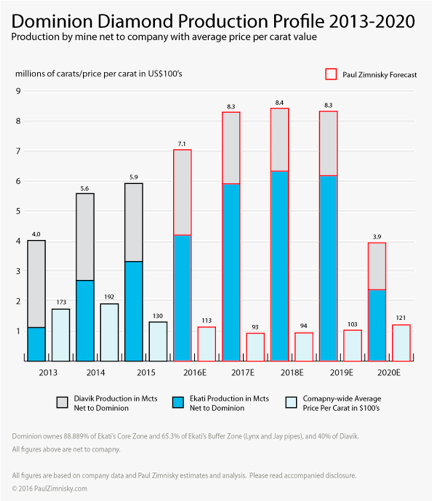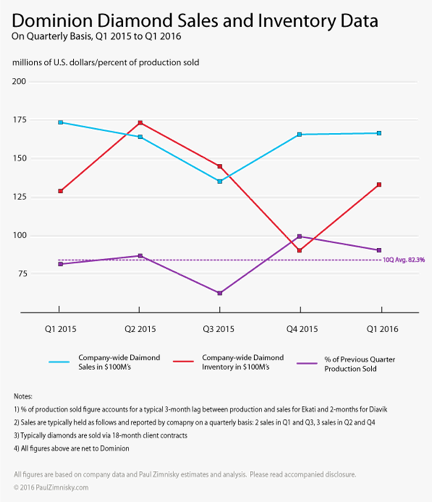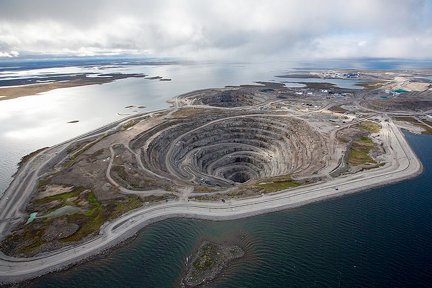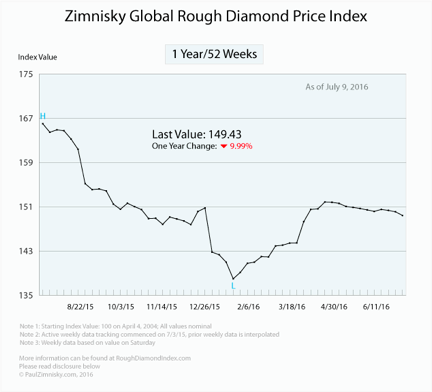Dominion Diamond stock apathetic amid significant production ramp
2016 has been a highly anticipated year for Dominion Diamond Corp (TSX/NYSE: DDC) with diamond production volume projected to increase significantly year-over-year with the commencement of mining at the company’s rich Misery Main pipe at its Ekati mine. Dominion is a pure-play diamond miner with an 88.9%* stake in Ekati, and a 40% stake in the Diavik mine (60% owned and operated by Rio Tinto, LSE: RIO), both of which are located in the Canada’s Northwest Territories.
Misery Main
Mining at Misery Main began slightly ahead of schedule in May with first sales expected to hit in calendar Q3, based on the company’s typical 3-month lag from production to sale. However, a processing plant fire that occurred on June 23rd, is going to set back production by approximately 3 months, rendering Q3 essentially a “lost quarter” at Ekati. While mining will continue at a reduced rate, processing will be completely halted until at least late September. Production at the company’s Daivik mine is unaffected by the incident, and will continue as normal.
The result of the plant shut down will be an increase in stockpiled ore, no production in Q3, and Q4 sales delayed until the end of Q4 or Q1 next year. In an effort to smooth 2016 production, Dominion indicated a plan to processes the highest grade stockpiled ore first when the plant is turned back on, which will produce the greatest diamond output volume possible with the plant running at full capacity.
The particulars of the fire were a damaged de-gritting circuit and related components, most likely caused by rubber and/or plastic materials related to the circuit catching fire from regular maintenance that required torching and cutting machinery. Given the timing of the incident, the repair parts need to be delivered by air due to the unavailability of the mine’s seasonal ice roads, increasing the timing and cost to complete the repair. The total repair cost is estimated at C$25M. Dominion does have an insurance policy that covers unexpected costs such as this, which includes the opportunity costs of being inoperable, however, the details of claim amount are still unavailable.
Production Plan
With the commencement of mining at Misery Main this year, Dominion’s production volume is estimated to increase an estimated 20% year-over-year (YoY) with the impact of the lost production resulting from the fire factored in. Company-wide, Dominion is estimated to produce 7.1M carats this calendar year, compared to 5.9M in 2015. 4.2M of those carats will come from Ekati (2.8M from Diavik), and 3.0M specifically from Misery Main.
Production is then estimated to increase another 17% to 8.3M carats next year, based on the assumption that Ekati will be fully up and running, and production uninterrupted in calendar 2017.
However, while Dominion’s production volume ramps, the company’s average price per carat is estimated to decline 13% this year and another 17% next year, from US$130/ct to US$113/ct, and then to US$94/ct, respectively. While Misery Main hosts very high-grade ore at >4.5 cts/ton, the actual quality of the production mix of diamonds is lower than what has been previously mined at Ekati. The assortment of diamonds are estimated to primarily be smaller and SI1 in quality, which are typical “U.S. bridal-quality” diamonds (ranked 6th in an 11 category grading scale of clarity).
The combined higher production volume, but lower value diamonds produced at Misery Main, influences an estimated 4% increase in company-wide revenue for Dominion this year, and a 2% YoY decline next year, or revenue of US$763M in 2015, US$794M in 2016, and US$776M in 2017.
The dynamic of higher volume produced, but of lower valued goods, inherently leads to greater leverage to market diamond prices for Dominion. For example, a US$1 increase in average price per carat achieved at Ekati would result in an estimated 1.2% increase in 2017 Ekati revenue, versus what would have just been a 0.7% increase in 2015 revenue.
However, even with diamond prices holding current levels, Dominion could generate significant free cash flow to equity (FCFE) over the next 4 years, estimated at US$172M, US$158M, US$82M, US$66M for 2016-2019, respectively (figures net of itemized US$431M in estimated Jay capex from 2016-2019, see below). Given that the company already has ~US$225M in cash and no debt, US$210M in additional liquidity from an unused credit facility, the company should have ample room to fund future project development, buy-back 6.2M shares, or 7% of the shares outstanding (as recently announced on July 7th, with purchases commencing as early as July 20th), and still have room to increase the dividend which currently yields 4.4%. For reference, Dominion’s current market cap is ~US$750M.
Jay
The largest foreseeable use of funds for project development will go towards Jay development, which hosts 78M carats and will extend the mine life of Ekati from 2022 to 2033. The ore body is below a lake and will require construction of a dike, which represents the largest portion of the projects estimated US$680M capex.
Jay has an after-tax NPV of US$398M, producing 7.9M carats annually at an estimated US$53/ct over 13 years. Jay is an “average-quality” project relative to other Canadian diamond development projects in the works, and is arguably only economic at current diamond prices because of Ekati’s existing infrastructure.
Stock Price
Dominion stock currently trades at a discount to peers, which can at least partially be attributed to the inconstancy of the company’s production plan since acquiring Ekati from BHP Billiton (ASX: BHP) in 2012. In addition, the company is currently searching for a new CFO, and has indicated interest in potential acquisitions in the space, which is counter to strategy favored by outspoken shareholders which would prefer that cash generated be returned to shareholders rather then spent on new project development and acquisition.
Diamond stocks have historically traded at a discount to other materials and mining companies because of the inherent challenge in underlying diamond pricing, the relative small size of the diamond mining universe, and a general lack of understanding of how the esoteric industry works.
According to the Zimnisky Global Rough Diamond Price Index, rough diamond prices are down 10.0% over the last 12-month, and up 4.7% year-to-date. Dominion stock is down 30.7% over the last 12-months, and down 12.7% year-to-date, and is currently trading at 4.3x 2016 FCFE, and 4.7x 2017 FCFE. For comparative purposes, similar sized materials and mining companies tend to trade at high single-digit to low double-digit FCFE multiples.
——
*Dominion owns 88.889% of Ekati’s Core Zone (Misery, Fox, Koala, Pigeon, and Sable pipes) and 65.3% of the Buffer Zone (Lynx and Jay pipes). Stewart Blusson owns the balance of the Core Zone, and Archon Minerals (TSX-V: ACS) owns the balance of the Buffer Zone.
At the time of writing Paul Zimnisky held a long covered-call position in Dominion Diamond Corp. Please read full disclosure below.
Paul Zimnisky is an independent diamond analyst and consultant and can be reached at www.paulzimnisky.com.
More News
{{ commodity.name }}
{{ post.title }}
{{ post.date }}






Comments